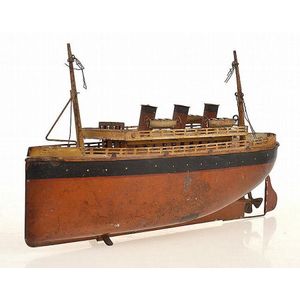An important live steam model of the 'Charlotte Dundas' circa 1870s, approximately 1:24 scale model, of the paddlewheel steamboat, constructed, according to family history, from timbers taken from the actual Charlotte Dundas which was scrapped in 1861, centrally mounted copper boiler, horizontal engine with piston driving a paddlewheel mounted to the stern of the boat, two steerable rudders controlled via a wheel to the foredeck, white lettering to hull N.M. 1817, engine untested, some restoration to hull and guard rail, with timber stand bearing on her Majesty's service. Department of Science and Art, London, S.W. Paper label inscribed in pencil Charlotte Dundas no 1817; two lithographic prints showing lateral sections of the original 1788 version of Symingtons steamboat and the 1801 version, of which this model is a representation; and an etching of William Symington the Inventor of steam Navigation, all three in frames made from hard wood believed to have been taken from the actual Charlotte Dundas; and a large archive of letters and documents relating to the history of the model including: international Exhibition, Glasgow, 1888 headed receipt listing the model and prints of the ship drawings. A letter to W.M. Rankine, great grandson of William Symington, from the Department of Science and Art, south Kensington Museum, dated 2nd April 1889, regarding collection of the model from the Museum relating to it being exhibited at the Paris Exhibition. A letter from the Deutsches Museum, Munich, to W.H. Rankin dated 23 March, 1906 asking for assistance to prepare a model. of this historical and extraordinarily important model. A photocopy of Biography of William Symington, published by A. Johnston, Bookseller, Falkirk, 1862 including three prints of a steam carriage and two versions of Symington's first steamboats W. H. Symington's copy of the Nature, Properties, and Applications of steam by John Scott Russell, Adam and Charles black, Northbridge, Edinburgh, 1861, green cloth boards three ambrotypes, believed to be of William Symington's ancestors, cased Exhibited: International Exhibition, Glasgow, 1888. Paris Exhibition, 1889 on loan to South Kensington Museum, London, 1889-1903. Immigration Museum, Melbourne 2003 other notes: Family history suggests that this model was made by John Rankine and W.H. Rankine, William Symington's grandson and great grandson. However, based on further research, copies of documents obtained from the Science Museum, London refer to a model that was built around 1873...under the supervision of James Hamilton, partner in Barclay, Curle Co. Shipbuilders on the Clyde. This is possibly the same model. William Symington (1764-1831) was a Scottish engineer and inventor who designed the first practical steam boat, the Charlotte Dundas. In 1787, aged only 23, he developed and patented an improved atmospheric engine based on the designs of James Watt and Thomas Newcomen. Large versions of his engines were used with great success in mining. For several years he conducted trials using his engines in land carriages and small boats. In 1800 he was approached by Lord Dundas, the governor of the Forth Clyde Canal Company to build a steam powered paddle boat. Lord Dundas had considerable commercial interest in the paddle boats that ran up and down the canals and saw steam power as a great opportunity to increase their efficiency. Symington designed and patented a horizontal engine which was trialled in a paddle steamer on the River Carron in 1801. However Lord Dundas was not satisfied with the boats performance on the canals so a new version was built, the Charlotte Dundas, named after Lord Dundas daughter. The Charlotte Dundas made its maiden voyage on 4 January, 1803. However, more significantly, on 28 March, in front of a large crowd, it successfully towed two laden vessels along the canal for more than 18 miles, becoming the first practical steamboat. Sadly, the Canal Company decided that the boat would cause too
You must be a subscriber, and be logged in to view price and dealer details.
Subscribe Now to view actual auction price for this item
When you subscribe, you have the option of setting the currency in which to display prices to $Au, $US, $NZ or Stg.
This item has been sold, and the description, image and price are for reference purposes only.
- Circa - A Latin term meaning 'about', often used in the antique trade to give an approximate date for the piece, usually considered to be five years on either side of the circa year. Thus, circa 1900 means the piece was made about 1900, probably between 1895 and 1905. The expression is sometimes abbreviated to c.1900.
- Live Steam - Live steam models are small, usually scale models of steam-powered vehicles or machinery that use real steam to power their movement. These models can be incredibly detailed and complex, often featuring working pistons, cylinders, and other steam-powered components.
Live steam models are typically made by hobbyists and enthusiasts, who enjoy building and operating these miniature steam-powered machines. They can be used to create working replicas of everything from steam locomotives and steamboats to steam engines and traction engines.
- Important - Important is a word used in the antique trade to indicate an object should be ranked above other similar objects, and is therefore more valuable.
The object could be considered important because it is by a famous designer or maker, has been shown at a major exhibition, is of exquisite workmanship, is rare or is a "one-off", was made for an important patron, and so on.
Even further up the pecking order are objects that are described in catalogue descriptions as highly important or extraordinarily important.
This item has been included into following indexes:




